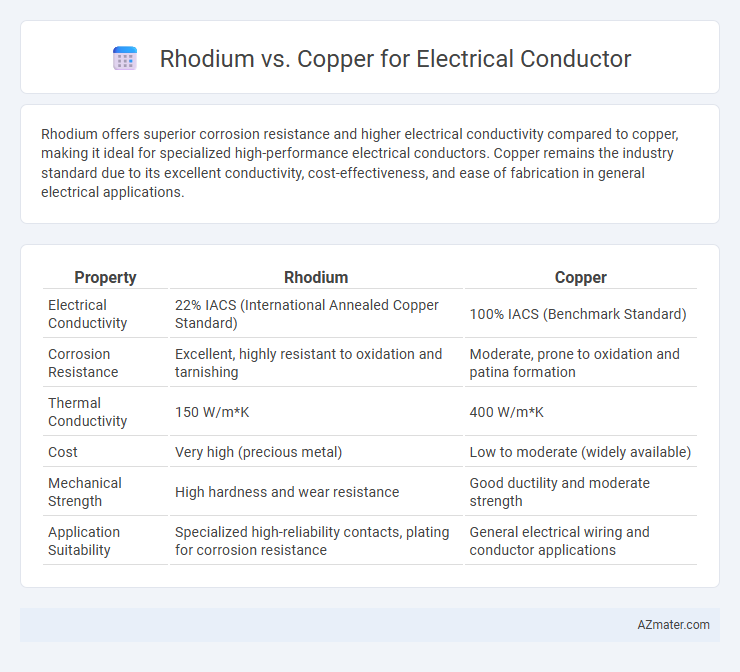Rhodium offers superior corrosion resistance and higher electrical conductivity compared to copper, making it ideal for specialized high-performance electrical conductors. Copper remains the industry standard due to its excellent conductivity, cost-effectiveness, and ease of fabrication in general electrical applications.
Table of Comparison
| Property | Rhodium | Copper |
|---|---|---|
| Electrical Conductivity | 22% IACS (International Annealed Copper Standard) | 100% IACS (Benchmark Standard) |
| Corrosion Resistance | Excellent, highly resistant to oxidation and tarnishing | Moderate, prone to oxidation and patina formation |
| Thermal Conductivity | 150 W/m*K | 400 W/m*K |
| Cost | Very high (precious metal) | Low to moderate (widely available) |
| Mechanical Strength | High hardness and wear resistance | Good ductility and moderate strength |
| Application Suitability | Specialized high-reliability contacts, plating for corrosion resistance | General electrical wiring and conductor applications |
Introduction to Electrical Conductors
Electrical conductors are materials that allow the flow of electric current with minimal resistance, playing a crucial role in power transmission and electronic devices. Copper is widely used due to its excellent electrical conductivity, thermal stability, and cost-effectiveness, making it the standard choice for most electrical applications. Rhodium, although less common and more expensive, offers superior corrosion resistance and high-temperature stability, making it suitable for specialized environments where durability and longevity are critical.
Overview of Rhodium and Copper
Rhodium and copper are both metals used in electrical conductors, with copper being the most widely utilized due to its excellent electrical conductivity of approximately 5.96 x 10^7 S/m and affordability. Rhodium, a rare and precious metal, exhibits lower electrical conductivity than copper but offers superior corrosion resistance and durability in harsh environments. While copper's abundant availability makes it ideal for standard wiring and electrical applications, rhodium's unique properties suit specialized uses where longevity and resistance to oxidation are critical.
Electrical Conductivity Comparison
Rhodium exhibits significantly lower electrical conductivity compared to copper, with copper ranking among the highest conductive metals at about 59.6 x 10^6 S/m, while rhodium's conductivity is approximately 23.1 x 10^6 S/m. This disparity makes copper more efficient for electrical conduction in most applications due to its superior electron mobility and lower resistivity. Despite rhodium's excellent corrosion resistance and durability, copper remains the preferred choice for wiring and electrical components where conductivity is the primary concern.
Thermal Conductivity Differences
Rhodium exhibits a thermal conductivity of approximately 148 W/m*K, significantly lower than copper's high thermal conductivity of about 401 W/m*K, making copper superior for heat dissipation in electrical conductors. The lower thermal conductivity of rhodium can lead to increased localized heating and reduced efficiency in electrical applications. Copper's enhanced thermal performance supports its widespread use in electrical wiring and components requiring efficient heat transfer.
Resistance to Corrosion and Oxidation
Rhodium exhibits superior resistance to corrosion and oxidation compared to copper, making it highly durable in harsh environments. Copper, while an excellent conductor, tends to oxidize over time, forming a greenish patina that can reduce electrical efficiency. The corrosion resistance of rhodium ensures long-term reliability in electrical contacts and connectors, especially in industrial and automotive applications.
Mechanical Properties and Durability
Rhodium exhibits superior mechanical strength and hardness compared to copper, making it more resistant to deformation under stress, which enhances its durability in high-wear electrical contacts. Copper provides excellent electrical conductivity but is softer and more prone to mechanical fatigue and wear over time. The durability of rhodium-coated conductors in harsh environments significantly exceeds that of copper, reducing maintenance and replacement frequency in critical electrical applications.
Cost and Economic Feasibility
Rhodium's high cost and rarity make it economically unfeasible for bulk electrical conductor applications compared to copper, which remains the industry standard due to its affordability and excellent conductivity. Copper's abundance and lower price enable widespread use in power transmission and electronics, while rhodium is typically reserved for specialized, high-temperature, or corrosion-resistant contacts where its cost can be justified. The significant price disparity, with rhodium pricing often exceeding copper by over 1,000 times per kilogram, limits rhodium's viability primarily to niche markets rather than general electrical conduction.
Common Applications in Electronics
Rhodium is rarely used as an electrical conductor in common electronics due to its high cost, but it excels in corrosion-resistant contacts, especially in automotive and aerospace connectors where reliability is critical. Copper remains the dominant conductor for electronic applications, valued for its superior electrical conductivity, affordability, and widespread use in wiring, printed circuit boards, and electromagnetic components. The choice between rhodium and copper depends heavily on balancing performance requirements, environmental conditions, and budget constraints in electronic manufacturing.
Environmental Impact and Sustainability
Rhodium offers superior corrosion resistance and longevity compared to copper, reducing the frequency of replacements and lowering environmental waste. Copper, while more abundant and recyclable, requires significant mining and energy for extraction, contributing to greater ecological disruption. Sustainable use of these metals emphasizes maximizing recyclability and minimizing mining impacts to balance performance with environmental stewardship.
Conclusion: Which is Better for Electrical Conduction?
Rhodium offers superior corrosion resistance and higher conductivity compared to copper, making it ideal for specialized, high-performance electrical applications despite its significantly higher cost. Copper remains the preferred choice for general electrical conduction due to its excellent conductivity, affordability, and widespread availability. For most industrial and residential wiring needs, copper provides the best balance of efficiency and economic feasibility, whereas rhodium is reserved for niche markets requiring exceptional durability and performance.

Infographic: Rhodium vs Copper for Electrical Conductor
 azmater.com
azmater.com